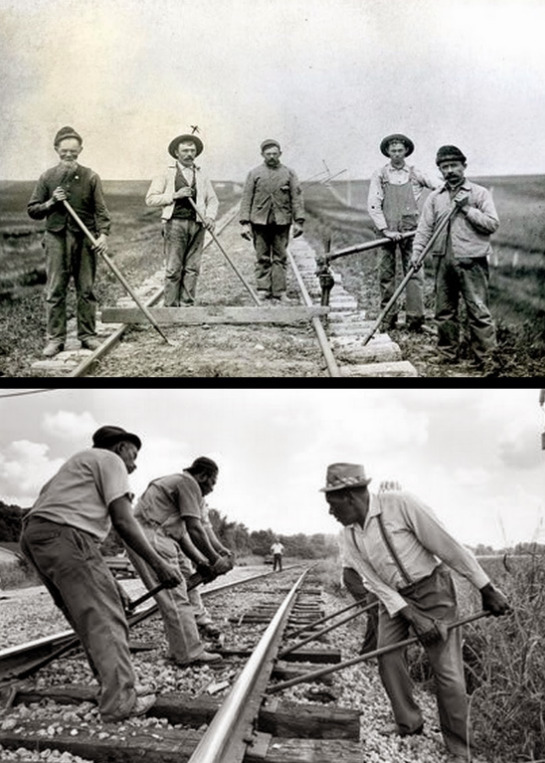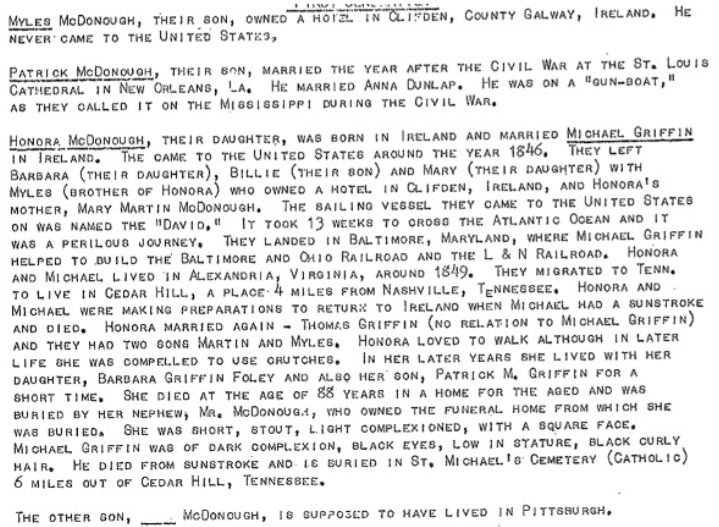Gandy Dancers

(Gandy Dancers at Work)
Editor’s Note: This one takes me back across family records, ancient times and modern digital records. Bear with me- it is a screed of sorts, but a way to approach some of the turmoil abroad in this fair land that recognizes some of the history being erased.
– Vic
It started with the train whistle from the tracks about a mile away. I knew that trains were in the family- Grandpa Mike had been an engineer. His grandfather was in trains as well, but of course he was a Gandy-dancer, not a driver.
There is a distinct difference and a little discourse on how things worked a couple centuries ago. Since our history is under what seems like a daily update cycle, it is appropriate to recall some ethnic history. One of the jokes that went along with our new Critical Thinking revolution was that men held in involuntary servitude were often held back from difficult or dangerous labor. They had, after all, cash value in the marketplace. Irish did not, as ostensibly free “daily labor,” or indentured servitude to pay the cost of the voyage. Our Irish were part of the 1846 flood of immigrants fleeing hunger and disease in the Emerald Isle. Ours landed in Baltimore, and relocated to Alexandria for work. Some of that was to help build the new Orange & Alexandria Railroad. That is the one we hear when the whistles on the engines sound.
Our town still has a train depot, and it was one of the reasons it thrived with agricultural commerce and was a target between warring armies. We were not as important then as the town a couple whistles south and west. That place was a town called Gordonsville.
At one time, it was the junction of traffic coming up from the Tidewater’s Atlantic reaches and the ones that flowed out of the rich an verdant Shenandoah Valley. It was a major destination in a minor but bustling area. The town grew up around a tavern established by Nathaniel Gordon in 1794, where the circle is today. After the railroad arrived in 1840, development began around the rail depot at the other end of town. By the 1850s they were filling in the gap, which is Main Street Gordonsville today. It is pretty cool and still boasts what some have termed the “Best Fried Chicken” in the state. There is a reason for that, and it involves the passage of women in bright skirts alongside waiting trains, bringing baskets of fried food on their heads to be sold and munched by hand on a waiting train.
Transportation was name of the game. Our Irish were just passing through, taking jobs on rail construction going west. All the way to Tennessee. They made it to Gordonsville, a significant economic hub and the center of 19th Century trade in Orange County, adjacent to our Culpeper. It featured the north/south tracks of what was then the Orange & Alexandria, (today’s CSX) and the east/west Virginia Central Railroad that connected Richmond with Staunton. The roads ran along as well, dirt but well-traveled. Today they are Rt. 33, the Rockingham Turnpike to Swift Run Gap and Rt. 231, the Blue Ridge Turnpike. The convergence of those historic routes with Route 15, at the traffic circle, position Gordonsville on the way to Virginia destinations in every direction. And every other place in this broad land connected to those steel rails.
Like everything here, it has a connection to the great conflict that roiled another century on these now peaceful fields. It goes without saying that we live in a place that is being overwhelmed by a slow invasion, again, as the hoard in DC seeks some country pleasure. In the conflict, it is said there were nearly a hundred thousand men who spent the Holiday season on our green pastures in two winter seasons, 1863 and 1864. They wore different colored uniforms in each extended stay, but we can show you the church Jeb Stuart attended in his time here, and the building with the tobacco store where the next season Lt. General Grant marched down to purchase his daily cigar ration. We are currently arguing over the name of our lake, currently honoring a courageous young man who defended our town. They will probably change it, but there are others who still capitalize the War, and use it only as a single noun.
Gordonsville was a critical crossroads in the Civil War, as key supply lines funneled through town by rail and road. The Federals tried on several occasions to capture this town, without success. They came close…to the top of Cameron’s (Bell’s) Mountain, but they never took the town. We are lucky to have the story of it, typed by Mom on her portable electric typewriter fifty or sixty years ago:

Mike was the family Gandy Dancer. His work on the B&O and L&N was part of the explosion of rail construction that included the Orange and Alexandria. The disparaging term was slang for early railroad workers in these parts, more formally referred to as “section hands.” They were the ones who laid and maintained the tracks before the invention of machines to do the hard work.
Chinese immigrants were also the recipients of that name, as they laid the tracks east for the first intercontinental connection. Some, perhaps more interested in enhancing the family history, claim it refers not to those who did the difficult work of track maintenance under the direction of an overseer. They claim Gandy Dancers were actually “track examiners”, responsible for “checking ties, bolts, track, and roadbed for necessary repairs.” There are various theories about the who-and-what of it, including a reference to the use of a five-foot long “lining bar” by teams of men dancing in unison to use it as a lever to keep the tracks in alignment.
Examination of the derivation will remain inexact. But the fact that Grandfather Mike died on the job indicates the dance he did was not of unalloyed joy. And had he lived long enough to conduct his return trip to Ireland, our story might indeed be a little different. The “dance” part of it likely refers to a reflection of the customs of the track crews.
To mitigate the effort, they sang songs while working to keep rhythm. Singing also helped to dispel the effort required to lift the rails, men shuffling carefully in time to the music and supposedly looking like a flock of waddling geese. This apparently led people to call track workers “gander dancers.” Remember there were gender issues in times before today’s curious convolutions. Then, it was corrupted into “gandy dancers,” though why ganders specifically instead of geese in general would be singled out is unknown. Perhaps it is a reference to the all-male nature of historic train crews.
Our pal Arrias let me know this little excursion into Irish families in America was not unique. He said: “At one point my dad, at age 18, was working his way through college (1940) and worked as a “Railway Express Agent” employee. He was mainly working as a clerk and helping out at a station in Boston, but apparently the company owned and was responsible for some track and he had to learn how to be a “Gandy dancer.” My brother Patrick still has I believe, the “lining bar” with the plate at the end to sit on and bounce (“Dance”) – I can still recall dad picking it up and showing us how to wedge it under a tie and then put his hand on the plate, sit on the plate and start bouncing. There was some ditty you sang to get the timing right with the other guys who were swinging the sledges… I recall the bar being in fine shape the last time I saw it (about 1990 maybe), at which point it was perhaps 70 years old and must have weighed 25 lbs.”
Whatever the origins of the term, gandy dancers also routinely rode the rails to inspect them. Every time a train passes, the vibration loosens the fixtures of the track, so it is important to tighten tracks, check for rotting or damaged ties, and clear hazards on the tracks such as downed trees. Gandy dancer crews historically used specially built lightweight track cars, which could be self-powered or powered by a small engine, to travel the sections of the track they maintained. That is probably the way our Grandfather made the jump from “lifting” to “driving.” It was a better change of status than laborer to “track examiner,” a fancy term for looking at miles of gleaming steel, only slightly rusted at the sides.
But I will leave defense of all titles associated with building the network that transformed America to those with personal interest. By the time our family was driving trains, the Gandy Dancers had undergone an ethnic transition of their own. It is all part of the history that is changing before our eyes. We think it is worth hanging on to it, if only to explain why some of the family died on them.
Copyright 2021 Vic Socotra
www.vicsocotra.com
